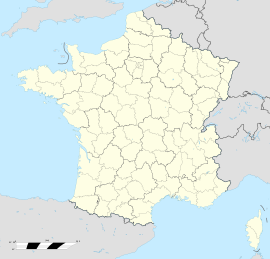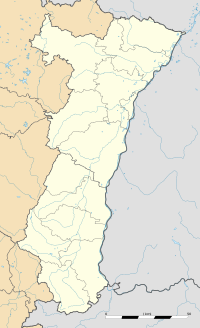- Neuf-Brisach
-
Neuf-Brisach

Administration Country France Region Alsace Department Haut-Rhin Arrondissement Colmar Canton Neuf-Brisach Mayor Maurice Zimmerle
(2001–2008)Statistics Elevation 194–198 m (636–650 ft)
(avg. 197 m/646 ft)Land area1 1.33 km2 (0.51 sq mi) Population2 2,219 (2006) - Density 1,668 /km2 (4,320 /sq mi) INSEE/Postal code 68231/ 68600 1 French Land Register data, which excludes lakes, ponds, glaciers > 1 km² (0.386 sq mi or 247 acres) and river estuaries. 2 Population without double counting: residents of multiple communes (e.g., students and military personnel) only counted once. Coordinates: 48°01′08″N 7°31′45″E / 48.0188888889°N 7.52916666667°E
Neuf-Brisach (German: Neubreisach) is a commune in the Haut-Rhin department in Alsace in north-eastern France.
The town's name means New Breisach, referring to the German town Breisach, located on the other side of the Rhine.
The aerial photography shows the layout of the town built as fortification. After the peace of Ryswick 1697 and the loss of Breisach to Habsburg, France built this fortified town to guard the border. Work began in 1698, to plans drawn by Vauban, a military engineer at the service of Louis XIV. Vauban died in 1707 and this, his last work, was completed by Louis de Cormontaigne.[1] The city's layout was that of an 'ideal city', as was popular at the time, with a regular square grid street pattern inside an octagonal fortification.[1] Generous space was given to a central square across the four blocks at the middle, flanked by an impressive church. Individual blocks were offered for private development, either as affluent houses in private gardens, or as properties for commercial rent. Simpler housing was provided in long tenement blocks, built inside each curtain wall, which also had the effect of shielding the better houses from the risk of cannon fire. Access was provided by large gateways in the principal four curtain walls.
The fortifications are Vauban's final work and the culmination of his 'Third System'.[1] There are two lines of defence, an inner enceinte de sûreté, the bastion wall around the city, and an outer enceinte de combat, a system of concentric star-shaped earthworks. The curtain wall was largely octagonal, with each flank separated roughly into three and the outer bastion projecting slightly, so as to flank the centre of the walls. Each corner had a raised outwardly-projecting pentagonal bastion tower, the highest points of the system. The outer earthworks were deep and occupied a greater area than the city itself. The inner walls were surrounded by tenailles before the centres of the curtain walls and counterguards before the bastions. In front of the centre of each curtain face was a large tetrahedral ravelin, those in front of the gateways also being topped by a reduit to the rear. Outside all of these earthworks was a covered way.[1]
The city suffered damage in World War II, but still represents a very clear example of the latest in fortification work at the beginning of the eighteenth century.
In 2008, the new town of Neuf-Brisach was listed as a UNESCO World Heritage Site, as part of the "Fortifications of Vauban" group.
Contents
People
- François-Joseph Offenstein (1760-1837) Commandant in chief of the town during the French Revolutionary Wars
- Vauban (1633-1707) military engineer who conceived the fortification of the city
- Saint-Just (1767-1794) French revolutionary leader
Gallery
 The moats and fortifications conceived by Vauban
The moats and fortifications conceived by Vauban
See also
References
External links
- All About Neuf-Brisach
- Neuf-Brisach. Trois siècles d'histoire de la fortification (French - Pictures - Animations)
- Neuf-Brisach: Pictures
- Webpage about the fortress of Neuf-Brisach
- A visit to Neuf-Brisach star fort
Arras • Citadel of Besançon • Blaye-Cussac-Fort-Médoc • Briançon • Camaret-sur-Mer • Longwy • Mont-Dauphin • Mont-Louis • Neuf-Brisach • Saint-Martin-de-Ré • Saint-Vaast-la-Hougue/Tatihou • Villefranche-de-Conflent
Categories:- Communes of Haut-Rhin
- Haut-Rhin geography stubs
Wikimedia Foundation. 2010.



